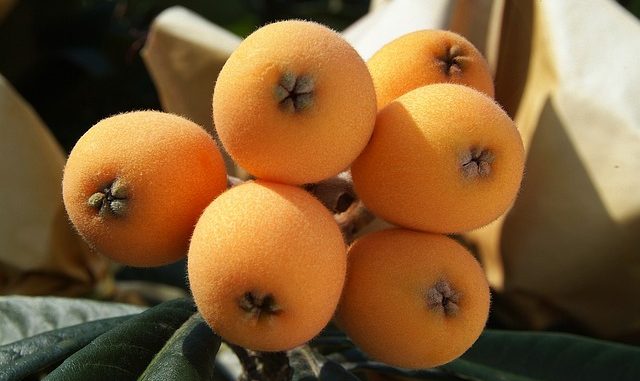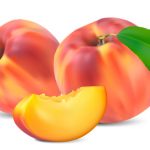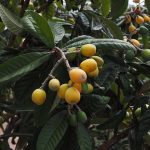
Loquat (Eriobotrya japonica (Thunb.) (Lindl.)) offers the product developer not only a strong nutritional profile but a rich yellow-orange colour suited to tropical beverages, confectionary and jam. The colour is due to a high carotenoid content and composition. There is potential to use loquat to provide a portion of antioxidants and provitamin A in beverages particularly.
The fruit is a non-climacteric type and is produced on an evergreen tree that flowers in the autumn and early winter, and ripens in the spring (Badenes et al., 2013) which is a benefit in the season when fresh fruits produced in temperate regions are not readily available. It is generally expensive because of the unique cropping period (Pinilos et al., 2011) and is attributed to its unusual phenology.
The fruit was originally from China but is mainly grown in tropical and sub-tropical regions such as Brazil, Turkey (Antalya province), the Middle East and Eastern Asia and the quality of the antioxidants, carotenoids and other putative bioactives depends on the cultivar, the environmental and growing conditions and the geography. The loquat is available in a number of different coloured varieties as the pulp from each cultivar range from yellow through to red although some white pulpy types are found. The colour is based on the carotenoid content and a good indicator of its nutritional benefit.
Some of the major cultivars are Akko XIII, Algerie, Centenária, Champagne de Grasse, Guzelyurt 6, Hafif Cukurgobek, KKTC 3, Mizauto, Mizuho, Mizumo, Néctar de Cristal and Sayda.
The Carotenoids Of Loquat
The carotenoid composition of some of the main Brazilian cultivars (Centenária, Mizauto, Mizuho, Mizumo, Néctar de Cristal) has been studied using high-performance liquid chromatography connected to a photodiode array and mass spectrometry detector (HPLC-PDA-MS/MS) (de Faria et al., 2009). This study interestingly found 25 different carotenoids which were separated on a C30 column of which only two could not be identified properly. The main carotenes were all-trans-β-carotene (19–55%), all-trans-β-cryptoxanthin (18–28%), 5,6:5′,6′-diepoxy-β-cryptoxanthin (9–18%) and 5,6-epoxy-β-cryptoxanthin (7–10%). The total carotenoid content ranged from 196 μg/100 g (cv. Néctar de Cristal) to 3,020 μg/100 g (cv. Mizumo).
Most varieties are strongly coloured being a vibrant deep orange however cv. Néctar de Cristal produces a cream-beige coloured pulp which indicates its low carotenoid content compared to the other fruits and determined in the aforementioned study. All the cultivars apart from cv. Néctar de Cristal would be good sources of provitamin A as they have values between 89 and 162 μg RAE/100 g.
The cultivars Mizauto, Mizuho, Mizumo and Centenária showed promise with high provitamin A values of between 89 and 162 μg RAE/100 g, and can be considered a good source of this nutrient.
The fruit might also provide a range of other bioactive compounds and these were investigated in an assessment of various Turkish cultivars (Ercisli et al., 2012). They found a wide variation in nutritional content especially total phenolics measured in gallic acid equivalents from 140 μg GAE/g (cv. Guzelyurt 6) to 253 μg GAE/g (cv. Akko XIII). The total phenolic content closely correlates with antioxidant potential so a variety such as Akko XIII would prove a useful fruit on those terms.
References
Badenes, M. L., Janick, J., Lin, S., Zhang, Z., Liang, G. L., & Wang, W. (2013). Breeding loquat. In: J. Janick (Ed.), Plant breeding reviews. http://dx.doi.org/10.1002/ 9781118497869.ch5 [Vol. 37].
de Faria, A. F., Hasegawa, P. N., Chagas, E. A., Pio, R., Purgatto, E., & Mercadante, A. Z. (2009). Cultivar influence on carotenoid composition of loquats from Brazil. J. Food Composition and Analysis, 22(3), pp. 196-203.
Ercisli, S., Gozlekci, S., Sengul, M., Hegedus, A., & Tepe, S. (2012). Some physicochemical characteristics, bioactive content and antioxidant capacity of loquat (Eriobotrya japonica (Thunb.) Lindl.) fruits from Turkey. Scientia Horticulturae, 148, pp. 185-189.
Pinillos, V., Hueso, J. J., Marcon, F., Jose, L., & Cuevas, J. (2011). Changes in fruit maturity indices along the harvest season in ‘Algerie’ loquat. Scientia Horticulturae, 129, pp. 769–776



Leave a Reply